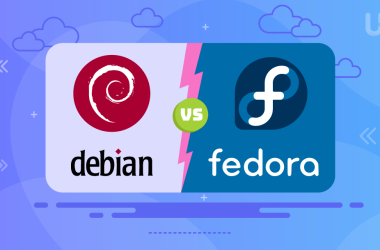Choosing the right Linux distribution is usually difficult, especially with popular choices like Fedora vs Ubuntu on the table. Both distros have distinctive features, strengths, and weaknesses targeted at different user needs. Knowing the differences between Fedora and Ubuntu can help make an informed decision for any user, from novices to experienced users or even developers.
In this article, we address some of the major points about the two distributions so that you can effectively decide whether to use Fedora or Ubuntu.
Overview of Fedora vs Ubuntu
The choice of the best Linux distribution is critical for any user, whether a newbie or someone who is more advanced in using a computer. Fedora vs Ubuntu, the two most popular Linux distributions with quite different features, philosophies, and user types, have been within the top two places. These main characteristics can help users decide which one to use.
Fedora
Fedora is the most advanced Linux distribution, invariantly developed and maintained by the Fedora Project, sponsored by Red Hat. Starting in 2003, Fedora gained a reputation for having the best innovative capacities within the Linux ecosystem. It works on integrating cutting-edge technologies and mainly acts as a playground for new features that might later be included in RHEL.
Fedora’s innovation involves fast release times and fresh software with updates while the newest pieces come out. This means the usual rate of releases is about twice a year, so in those cycles, users get to use the latest pieces developed by open-source community members. This is how Fedora pushes the boundaries on what’s possible using Linux; a great way to make it popular among developers, tech-savvy users, and anyone just eager to try bleeding-edge solutions.
Ubuntu
The other is Ubuntu, a very popular distribution maintained by Canonical Ltd. Ubuntu has since 2004 attempted to popularise Linux for everybody, regardless of whether one has technical skills. Known for user-friendliness, large community support, and the ability to release frequently, these characteristics have made this distribution an all-time favorite among many individuals, from newbies to more advanced users in the world of Linux.
The main purpose of Ubuntu is to be a stable, secure, easy-to-use base for inquiry, supporting desktops, servers, and IoT devices. The goal is achieved through prudently chosen software, extended testing, and a clear focus on usability. At the same time, Ubuntu has an intuitive user interface that helps beginners get familiar with the environment, thus making it easier to start using Linux.
Installation and Setup
Fedora Installation
The Anaconda installer makes Fedora’s installation process easy. It has a guided graphical interface for the average user and an advanced mode for customized installations. However, Fedora’s installer can be a bit more complex for a beginner than Ubuntu’s.
Ubuntu Installation
Since Ubuntu uses the Ubiquity installer, it is really easy. This installation is very fast and intuitive, perfect for those new to Linux. There is a large amount of documentation and community support for installation and troubleshooting in Ubuntu.
Desktop Environments

Fedora
Though Fedora mainly comes with the GNOME desktop environment for a modern and sleek user interface, it also employs Spins, which come with different working environments: KDE Plasma, Xfce, and LXQt.
Ubuntu
In addition, Ubuntu’s default desktop environment is GNOME, though it has been customized in a better way with Ubuntu Dock and some other modifications for a remarkable outlook and feel. Besides that, Ubuntu offers official flavors such as Kubuntu with KDE Plasma, Xubuntu with Xfce, and Lubunter with LXQt, respectively, according to users’ different tastes.
Package Management
Fedora
Fedora uses the RPM system, and package management uses the DNF package manager. So far, DNF has adopted all of the existing Fedora Package Manager—DNF Policies to support the smooth operation of Selinux. It is efficient and robust, allowing users to install, update, and remove software packages easily. If you require a specialized environment for security testing, consider a Kali Linux VPS Hosting solution.
Get The Best Ubuntu VPS To Meet Your Needs!
Ready to experience the power and stability of Linux distributions? UltaHost offers top-notch Ubuntu VPS solutions that are perfect for developers, businesses, and tech enthusiasts alike. Get unparalleled performance, robust security, and reliable support.
Ubuntu
It uses the DEB package format and employs APT, the Advanced Package Tool, as its package manager. APT is extremely intuitive to use and has wide applications; this repository of software packages runs into thousands. Most of the time, Ubuntu’s package management is more user-friendly for beginners.
Software Availability
Fedora
Fedora is focused on having the latest versions of software. This ensures that users can use very recent applications and features. However, this process sometimes leads to instability in the new, relatively untested software.
Ubuntu
It considers stability and security by providing tested software. Ubuntu Software Center provides an expansive repository for applications, and users may also enable third-party repositories or PPAs for other software installs.
Release Cycle and Stability
Fedora
Fedora has implemented a fast release cycle, meaning major releases happen every six months. This means that the user will run the latest technology and improvements. On the other side, these frequent updates require more maintenance and can provide instability.
Ubuntu
Ubuntu offers a cadence of regular releases, six-monthly versions of the operating system, plus LTSs every two years. This basically implies that each operates for a period of five years before a new version is introduced. It provides a reliable and stable run-time environment for production systems or long-running project cycles.
Community and Help
Fedora
It has an active community of developers and users who assist through forums, mailing lists, and IRC channels. The Fedora Project also offers considerable documentation and resources on troubleshooting and learning at your own pace.
Ubuntu
This now boasts the largest and most active community in the Linux world. In this version, users can make use of forums, Ask Ubuntu, and several online resources to get support. For hosting needs, CloudLinux VPS Hosting can provide the stability and support required for enterprise environments. Canonical provides professional support services for enterprise users.
Security

Fedora
Fedora is known to be strong in security, with very fine-grained access control using SELinux. It gives further rigid security through mandatory access controls. Having the fastest release cycle, updates and patches are rapidly deployed in light of providing data security.
Ubuntu
The key concept in Ubuntu is the formation of a secure environment by default. In most cases, AppArmor complements traditional Unix-like discretionary access control. The point releases of Ubuntu’s LTS get security updates for five years, so this means that you will have a safe and stable system for a long time.
Performance
Fedora
Many people describe Fedora as quite performant—they call it efficient, especially with fairly recent hardware and technologies. Since Fedora is on the edge of updates, it can leverage new developments to guarantee a fast and responsive experience.
Ubuntu
It is developed with a focus on high performance and stability. This is especially true for its LTS releases. Rigorous testing and optimization mean that Ubuntu runs on a great variety of hardware—from old machines to modern desktops and servers.
Customization
Fedora
Fedora gives users a great degree of customization, allowing them to make the system workplace as comfortable as possible. The GNOME desktop environment is minimalistic and can thus be extended and customized with many extensions and themes.
Ubuntu
Customization is Ubuntu’s middle path. It provides an easy-to-use environment that is customizable up to a certain extent. The Ubuntu Dock and other GNOME customizations make it easy for any user to customize according to their preference without fudging complexity.
Conclusion
The choice between Fedora vs Ubuntu will have to be based on your needs and tastes in general. Fedora is in order if it is the newest of new, fast updates, ready to sweat a bit. On the contrary, if one needs something stable, easy to use, and with long-term support, Ubuntu should be your way to go.
Ubuntu vs Fedora are both powerful, flexible, and strong Linux distributions that would please a large segment of users—from the freshest newbies to the most advanced pros. All you need to do is understand the main differences and strengths between each so you know which to choose and find your distro soulmate. Whether you choose Ubuntu or Fedora, you get a rich and fulfilling Linux experience.
Whether you choose Fedora or Ubuntu, both offer exceptional Linux experiences tailored to different user needs. For a powerful, secure, and reliable Linux VPS hosting solution, consider UltaHost – where top-tier performance meets unparalleled support.
FAQ
Can I switch between Fedora and Ubuntu easily?
Yes, you can switch by backing up your data, creating a bootable USB for the new distro, and reinstalling your software. Ensure all important files are backed up before switching.
Which distro is better for running a server?
Ubuntu is generally preferred for servers due to its Long-Term Support (LTS) versions, which offer five years of updates. Fedora is better for environments needing the latest features and technologies.
How does Fedora’s security model differ from Ubuntu’s?
Fedora uses SELinux for robust access controls, while Ubuntu uses AppArmor, which is easier to configure but less granular. Both provide strong security, with Fedora’s SELinux being more advanced.
Are there specific industries where Fedora excels over Ubuntu?
Due to its rapid integration of new features, Fedora is ideal for environments needing the latest technology, such as tech startups, research institutions, and software development firms.
What kind of support can I expect from Fedora and Ubuntu?
Ubuntu offers extensive community resources and professional support through Canonical. Fedora has a vibrant community with comprehensive documentation, but Ubuntu’s professional support is more widely recognized for enterprises.











